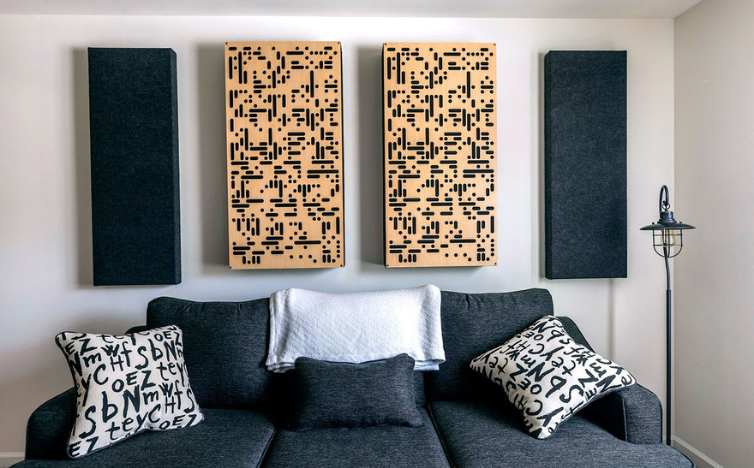Managing low-frequency sound is one of the most challenging aspects of room acoustics, especially in environments such as recording studios, home theaters, and performance spaces. Bass traps are a specialized acoustic treatment designed to control these problematic low-end frequencies. In this article, we’ll be understanding bass traps mechanism and why they are essential for effective low-frequency sound control.
What Are Bass Traps?
Bass traps are acoustic panels specifically designed to absorb low-frequency sound waves, typically between 20 Hz and 250 Hz. These frequencies, often referred to as bass frequencies, can cause muddiness and an uneven sound environment if not properly managed. Bass traps are usually made from porous materials like foam or fiberglass, which slow down sound waves and convert sound energy into heat, reducing the reverberation of low-frequency sounds.

The Problem with Low-Frequency Sound
Low-frequency sound waves are larger and more powerful than higher frequencies. As a result, they are harder to absorb and control. When these sound waves hit a wall or corner, they can create resonant frequencies or “standing waves,” which cause an imbalance in sound clarity. Without proper low-frequency absorption, these standing waves result in boomy bass, making it difficult to achieve clear and balanced sound in a room.
How Bass Traps Work
Bass traps operate by targeting low-frequency sound waves that tend to gather in the corners and edges of rooms. Here’s how they function:
- Absorption of Low-End Frequencies: Bass traps are strategically placed in corners where low-frequency sound waves are strongest. Their porous material absorbs these waves, reducing their amplitude and preventing them from reflecting back into the room.
- Reducing Resonance: By absorbing excess low frequencies, bass traps minimize resonances that can distort sound, resulting in a more balanced and clear acoustic environment.
- Improving Overall Acoustics: When low frequencies are properly controlled, the mid and high frequencies in the room also become clearer, leading to improved sound quality.
See Also: Acoustic Panels vs. Bass Traps: Which is More Effective?
Types of Bass Traps
There are various types of bass traps available, each with specific applications depending on the room size, layout, and acoustic needs.
1. Corner Bass Traps
Corner bass traps are placed in the corners of rooms where low-frequency sound waves tend to accumulate. Their triangular or wedge shape makes them perfect for absorbing sound in these critical areas, leading to better overall control of low-end frequencies.
2. Broadband Bass Traps
Broadband bass traps are designed to absorb a wide range of frequencies, from low to mid-range. They are versatile and can be used in various locations within a room, making them ideal for home studios or small spaces where sound control is essential.
3. Panel Bass Traps
Panel bass traps are flat, rectangular traps that can be mounted on walls. These traps are effective for targeting specific areas where bass frequencies create resonances, offering additional flexibility in sound treatment.
Why Bass Traps Are Essential for Sound Control
Bass traps are vital for maintaining a balanced acoustic environment, especially in professional recording studios, home theaters, and listening rooms. Here are a few reasons why they are essential:
- Improved Sound Clarity: Bass traps help remove unwanted low-end noise, creating a cleaner, more accurate listening experience.
- Enhanced Recording Quality: For audio engineers and musicians, controlling low-frequency sound is crucial for accurate mixing and mastering.
- Balanced Room Acoustics: When used correctly, bass traps ensure that the entire frequency spectrum is well-balanced, making it easier to achieve high-quality sound.
Where to Place Bass Traps
Correct placement of bass traps is key to maximizing their effectiveness. Typically, bass traps should be positioned in the corners of the room, including vertical and horizontal corners, where low-frequency build-up is most pronounced. Additionally, placing them along walls can help target specific areas with excessive bass resonance.
Key Placement Areas:
- Room Corners: Low-frequency energy tends to gather in room corners, making them a priority for bass trap placement.
- Wall-Wall and Ceiling-Wall Junctions: These spots are also prone to sound reflections and standing waves.
- Behind Speakers: Positioning bass traps behind speakers can further reduce unwanted reflections and improve sound clarity.
Call us: Contact Waseem Technical Soundproofing Expert in Dubai For Soundproofing: +971 50 209 7517
Conclusion
Controlling low-frequency sound is crucial for achieving high-quality acoustics in any room. Bass traps are one of the most effective solutions for managing these frequencies and ensuring that your sound environment is balanced and free of unwanted noise. Whether you’re setting up a recording studio or simply want better sound in your home theater, bass traps provide a simple yet powerful solution for low-frequency control.
By understanding the science behind bass traps, you can optimize your space’s acoustics and enjoy a more precise and enjoyable audio experience.




